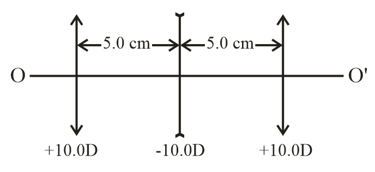HARD
JEE Main
IMPORTANT
Earn 100
There are two thin symmetrical lenses, one is converging with refractive index , and the other is diverging with refractive index . Both the lenses have the same curvature radius of their surfaces, equal to . The lenses were put close together and submerged into water. What is the focal length of this system in water? Refractive index of water in air is .

Important Questions on OPTICS
HARD
JEE Main
IMPORTANT
Figure illustrates an aligned system consisting of three thin lenses. The system is located in air. Determine,

the position of the point of convergence of a parallel ray incoming from the left after passing through the system,
the distance between the first lens and a point lying on the axis to the left of the system, at which that point and its image are located symmetrically with respect to the lens system.
HARD
JEE Main
IMPORTANT
HARD
JEE Main
IMPORTANT
(a) the width of a fringe on the screen and the number of possible maxima;
(b) the maximum width of the slit at which the fringes on the screen will be still observed sufficiently sharp.
HARD
JEE Main
IMPORTANT
HARD
JEE Main
IMPORTANT
HARD
JEE Main
IMPORTANT
HARD
JEE Main
IMPORTANT
An isotropic point source emits light with wavelength . The radiation power of the source is . Find
(a) the mean density of the flow of photons at a distance from the source.
(b) the distance between the source and the point at which the mean concentration of photons is equal to .
Planck's constant and speed of light
MEDIUM
JEE Main
IMPORTANT
